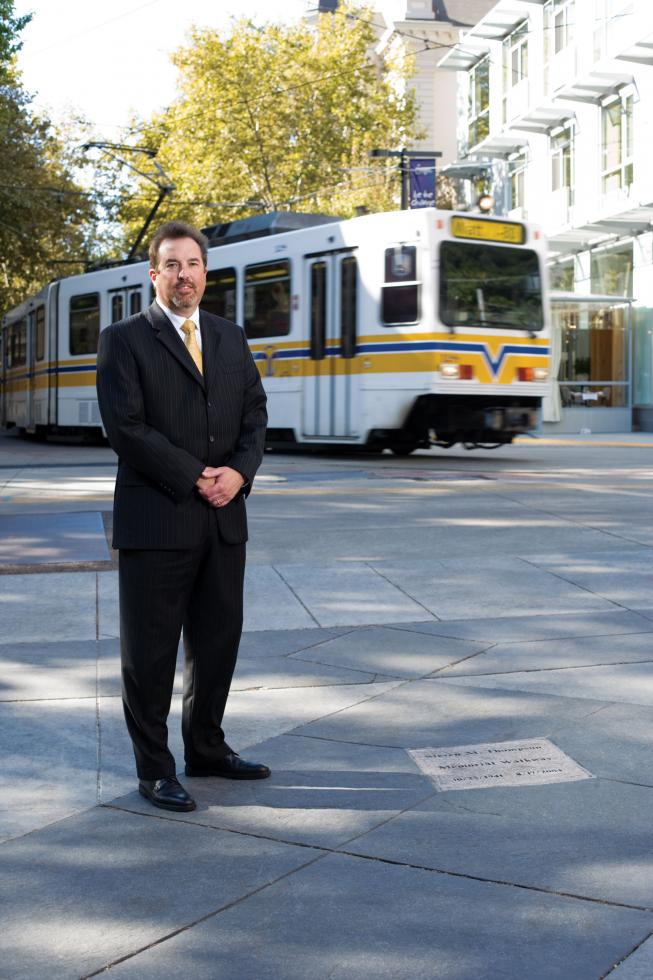Ed Manning, lobbyist and environmental lawyer, KP Public Affairs
(Photo: Mike Graffigna)

California’s cities and counties are facing the formidable challenge of determining how they’ll tackle regulations outlined in the state’s greenhouse gas legislation.
Gov. Arnold Schwarzenegger signed Assembly Bill 32, the Global Warming Solutions Act, in 2006. Proponents call it a “landmark” bill that seeks to reduce California’s greenhouse gas emissions by 25 percent by 2020.
The glitch for policy makers in the trenches is the legislation’s omission of how, exactly, these benchmarks are to be reached, who is in charge of implementing them and how to reconcile the fact that the residential housing industry — not commercial, farming or infrastructure — is the primary beneficiary of the legislation’s perks.
For some time, it looked like the regulatory baton would be handed in its entirety to the California Air Resources Board. Stakeholders were wide-eyed about the ARB governing implementation, and that’s in part how Senate Bill 375 — the implementation component of AB 32 — came about last year.
“Without SB 375 you could have had the ARB dictating to local jurisdictions what their terms and land-use plans need to look like,” says Ed Manning, the lobbyist and environmental lawyer at KP Public Affairs who was the lead negotiator for business interests on the legislation. “They were talking about putting mandates on every general plan … and micromanaging local governments. Part of this legislation came in reaction to that.”
Authors of SB 375 modeled it after the Sacramento region’s planning blueprint, which allows jurisdictions to formulate their own plans to curb urban sprawl. The legislation has three pieces: sustainable transportation and land use, affordable housing and reforming the California Environmental Quality Act. Communities working in compliance with SB 375 could find it easier to develop their residential projects.
“The actual regulations, targets and methodologies are still undefined, so we are trying to navigate in uncharted waters.”
David Morrison, assistant director of planning, Yolo County
Historically, developers have had to determine how their projects would affect regional growth and greenhouse gas emissions. The process could easily consume a hefty slice of a developer’s time and money because the requirement was so broad. But under the new law, local governments would handle the regional environmental planning; developers would build according to the jurisdiction’s master plan and only offset the environmental impacts from their individual projects.
The method stands to streamline zoning and permitting and cut down on costs, lost time and environmental lawsuits for developers who work within the scope of a jurisdiction’s master plan. Development can still occur outside of that scope, but the projects couldn’t necessarily seize the CEQA benefits or streamlined permitting.
“It should become less expensive for [developers] to build because we’re trying to clear the regulatory [barriers],” says Mike McKeever, executive director of the Sacramento Area Council of Governments. “The front end … is a very expensive and risky time for developers. It’s cash out of their pockets, and they have no guarantees. If you can take some of the risk out because the local government worked with CEQA upstream, you know you’re pretty much home free.”
Well, some developers would be home free. The legislation doesn’t include the same benefits for commercial and infrastructure development, and it’s vague about legal protection, even for projects that meet the law’s requirements.
“It gives the residential construction folks freedom from impacts and CEQA documents, but they don’t do that for roads, schools, health facilities, hospitals or commercial projects,” says Rex Hime, president and CEO of the California Business Properties Association. “Plus, there is no finality, no safe harbor.”
Each of California’s 18 regions will be given emission reduction figures by the ARB. That number has to be met by 2020, or jurisdictions risk financial backlash, rezoning mandates and decreased autonomy from the state. Transportation projects and programs, for example, must be consistent with sustainable building plans to receive state funding.
“After you do all this, you could still be challenged or sued because there can always be someone who says it isn’t enough,” Hime says. “If you have the state giving the regions their goals — and they are implementing their goals — why could they still be at risk for being sued for greenhouse gas emissions?”
One of the largest sources of greenhouse gases in California is passenger vehicles, according to the state, so in order to reduce those emissions, local planners and developers are now focused on getting residents out of their cars and onto public transportation.
For Stockton and Sacramento, articulating those goals in words and numbers isn’t all that burdensome because planners have been ahead of the game.
“Without SB 375 you could have had the ARB dictating to local jurisdictions what their terms and land-use plans need to look like.”
Ed Manning, lobbyist and environmental lawyer, KP Public Affairs
“Even before the implementation of AB 32 and SB 375, our region had decided to grow smart with a blueprint focused on growth in transportation corridors, reducing car trips per capita, mid- and high-density housing and decreased pollution,” McKeever says.
In Stockton, a climate action plan was the result of a recent settlement agreement with the Sierra Club after the environmental advocacy group sued the city for failing to address climate change in its general plan.
One component of Stockton’s settlement would be the construction of 4,400 dwelling units in the greater downtown area and another 14,000 units in the city’s infill area. The city has also been working on a transit gap analysis to identify areas where ridership can be improved, according to Mike Niblock, the city’s community development director.
The challenge in Sacramento, Stockton and beyond, however, is bringing those plans to fruition.
Gov. Arnold Schwarzenegger signed SB 375 in 2006.
(Photo courtesy of the office of the governor)

“So far, we have just identified what the targets are,” Niblock says. “There are some formulas out there that we can use to try to reduce vehicle miles and things like that, and we are looking at better planning from a land-use perspective, but that’s about all we can do. Something like two-thirds or three-fourths of emissions are outside the local control. There are other polluters that need to be controlled at the state level, not at the local level.”
The ARB is defining the new regional standards now, and the next step will be figuring out how to act. And it’s the how that’s the hang-up.
“Obviously a number of state agencies are working on the issue, but the actual regulations, targets and methodologies are still undefined, so we are trying to navigate in uncharted waters,” says David Morrison, assistant director of planning for Yolo County. “Some jurisdictions have looked at the issue on a fairly preliminary level; other jurisdictions are farther along. Yolo County is taking a much more comprehensive look at climate change by the way we design our communities.”
In writing SB 375, lawmakers envisioned development patterns in which people live closer to jobs, services and transit. The ARB found that, even if cars become cleaner and more efficient, target emission levels couldn’t be met without reducing vehicle miles traveled. For many jurisdictions, determining how to attain the ARB’s upcoming benchmarks begins with public transportation planning, and, more specifically, how best to stretch scant funds.
“In the transit-planning world, there is always this Catch 22 wherein, in order to be cost effective, it needs to serve high-density populations,” McKeever says. “You need an urban settlement pattern. But the reverse it true, too. In order for a successful urban pattern to function, you need high-quality transportation.”
McKeever’s SACOG board adopted the Preferred Blueprint Scenario as part of the council’s six-county Metropolitan Transportation Plan for 2035, which promotes compact, mixed-use development and more transit choices as an alternative to low-density development.
Similarly, the Yolo County general plan projects higher-density communities with jobs, shopping and housing in close proximity.
Recommended For You

Power Savers
Energy-efficient retrofits boost bottom lines
When California’s building industry began to crumble in 2008 — with 2009 producing the lowest number of homes built since 1954 — veteran contractors like Jim Bayless scrambled to reinvent themselves.

A Slow Pace?
Some programs for green retrofits remain in limbo
There’s a lot of legal hubbub in California surrounding Property-Assessed Clean Energy programs. Also known as PACE, the programs could be headed for troubled waters.


